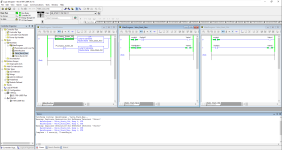jimbob89
Member
Hi all,
Is anything wrong with the hypothetical logic attached?
We make a machines that can have 1 of 2 air valve stacks. I would like the person who initially tests the machine to turn on a bit on a configuration screen that decides whether it will run the valve stack new or valve stack old routine.
Valve1 and Valve 2 are aliased to real world solenoids. Switch1, switch2, and Pushbutton1 are aliased to inputs as well.
Seems to work but am I missing something? I get that it could be possible to run the incorrect valve stack program and possibly turn on the valve under the incorrect conditions but it can't physically harm the machine or operator.
Jimbob

Is anything wrong with the hypothetical logic attached?
We make a machines that can have 1 of 2 air valve stacks. I would like the person who initially tests the machine to turn on a bit on a configuration screen that decides whether it will run the valve stack new or valve stack old routine.
Valve1 and Valve 2 are aliased to real world solenoids. Switch1, switch2, and Pushbutton1 are aliased to inputs as well.
Seems to work but am I missing something? I get that it could be possible to run the incorrect valve stack program and possibly turn on the valve under the incorrect conditions but it can't physically harm the machine or operator.
Jimbob





